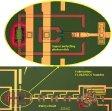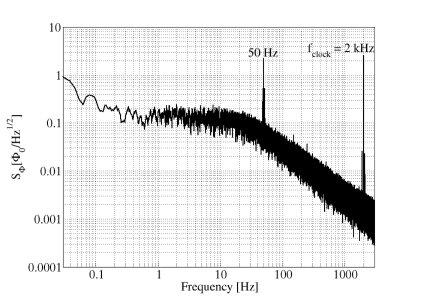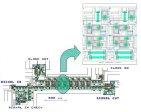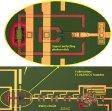Headed by Pascal FEBVRE
Context and objectives
Research activities on superconducting electronics are mostly based on Rapid Single-Flux-Quantum (RSFQ) digital Electronics. Associated digital circuits use the Josephson tunnel junction as the basic component that is, for superconducting electronics, the device equivalent to transistors in the semiconductor world.
RSFQ circuits use Josephson junctions that are resistively shunted in a careful way in order to be able to generate, propagate and store the binary information through quanta of magnetic flux h/2e (h is Planck's constant and e is the elementary charge) corresponding to 2,0710-15 Wb. This binary information propagates through the circuit as quantized voltage pulses whose area is 2.07 mV.ps. The pulse duration being of the order of a few picoseconds, the repetition rate of such pulses, that is the maximum clock frequency that RSFQ circuits can handle, is of several tens to several hundreds of GHz. Pulse propagation takes place without losses in the superconducting circuits at a speed close to half the light speed. The presence of a quantized pulse in a given time interval is digitally coded as '1', while the absence of such pulse is coded as '0'. Binary information is stored in the circuits as a permanent current running in a superconducting loop. The flux associated to this current corresponds to the magnetic flux quantum: it equals L I = 2,07 pH.mA, where L is the inductance of the storing loop.
Superconducting electronics is of great interest for several niche applications, like ultrafast routers for communication networks, analog-to-digital converters working in the microwave field, and ultra sensitive digital receivers, which have no counterpart in the semiconductor world.
Expertise
Activities in the RSFQ field have started in 1997 on the Savoie-located part of the laboratory; this provides us an expertise unique in France. We have established a software environment for RSFQ design, along with measurements benches that allow us to perform routine laboratory tests of RSFQ circuits. We have also tested RSFQ circuits in a specific low-noise underground environment in the frame of the digital SQUID activities. The RSFQ circuits that are being studied are so far fabricated by the FLUXONICS foundry in the frame of a European collaboration.
Opto RSFQ Inteface

Optical synchronisation device for RSFQ integrated circuits. This device has been fabricated by the FLUXONICS European foundry. It allows synchronising optically RSFQ circuits with external optical signals, consequently minimizing jitter in RSFQ circuits.
Superconducting photoswitch integrated with a superconducting digital RSFQ circuit made of a Josephson transmission line and an SFQ/dc output interface.
Contact : Pascal FEBVRE
Supports : Egide PROCOPE: collaboration with the University of Technology Ilmenau (Germany)
See for instance: P. Febvre, H. Toepfer, T. Ortlepp, B. Ebert, S. Badi and F. H. Uhlmann, Superconducting photosensitive interfaces for triggering RSFQ circuits, IEEE Transactions on Applied Superconductivity, vol.17, no.2, pp.530-533, June 2007.
DigitalSQUID Magnetometer

Cryogenic device based on a digital SQUID including 2 sets of Helmholtz coils for performance calibration purposes. The 5 mm x 5 mm microelectronics chip that includes the digital SQUID is installed in the holder shown below the cryogenic head. Bottom: Flux noise spectral density of the digital SQUID magnetometer.

Spectral density of noise of stream magnetique of a digital SQUID magnetometer.
This device is the first all-digital magnetometer based on Superconducting Quantum Interferometers (SQUIDs). It allows suppressing environmental noise directly at the sensor level while keeping the quantum accuracy of the magnetic flux quantum. Its resolution is 0,22 milliquantum of magnetic flux, obtained with signal integration. Its dynamic range is higher than 75 dB (14800 magnetic flux quanta). This device, fabricated at the European FLUXONICS foundry, has been tested in July 2007 in real conditions environment to detect signatures of Earthquakes at LSBB (Laboratoire Souterrain à Bas Bruit) in Rustrel (Provence - France).
Contact : Pascal FEBVRE
Supports :French-German PROCOPE Egide program with University of Technology Ilmenau (Germany). Micronano cluster of the french Rhône-Alpes Région.
See for instance : T. Reich, Th. Ortlepp, F.H. Uhlmann and P. Febvre, Experimental analysis of a digital SQUID device at 4.2 K, Superconductor, Science and Technology, vol.18, no.8, pp. 1077-1081, August 2005.
Design of RSFQ Analog-to-Digital Converters (ADCs)

Example of an 8-bit shift register to process RSFQ circuits after digitization. A close-up view on the top displays 2 bits of the register, made of D-Flip-Flop and splitter cells.
The RSFQ pulse rate at the output of the analog-to-digital converter being higher than 100 Gbits/sec, it is necessary to process the signal on-chip in a digital manner in order to interface it with on-the-shelf room-temperature electronics. For instance, it is useful to have decimation filters. A library composed of several miscellaneous cells is being developed to build RSFQ circuits that can achieve the desired functional behaviour.
Contact :Pascal FEBVRE
Supports : National Research Agency project HyperScan with MINALOGIC label: Portage de circuits intégrés Hyper-fréquences Supraconducteurs de Conversion Analogique-Numérique sigma-delta, 200 GHz pour les applications radio logicielle et télécommunications spatiales. European network SCENET-II.
See for instance : H.J.M. ter Brake, F.-Im. Buchholz, G. Burnell, T. Claeson, D. Crété, P. Febvre, G.J. Gerritsma, H. Hilgenkamp, R. Humphreys, Z. Ivanov, W. Jutzi, M.I. Khabipov, J. Mannhart, H.-G. Meyer, J. Niemeyer, A. Ravex, H. Rogalla, M. Russo, J. Satchell, M. Siegel, H. Töpfer, F.H. Uhlmann, J.-C. Villégier, E. Wikborg, D. Winkler and A.B. Zorin, SCENET Roadmap for Superconductor Digital Electronics, Physica C, Vol. 439, issue 1, pp. 1-42, 2006.
Research projects
ANR project:
HyperScan ( Minalogic label)
FP7:IST:
S-Pulse Shrink-Path of Ultra-Low Power Superconducting Electronics
EGIDI/PROCOPE:
collaboration with l'University ofTechnology Ilmenau ( Germany)
HyperScan ( Minalogic label)
FP7:IST:
S-Pulse Shrink-Path of Ultra-Low Power Superconducting Electronics
EGIDI/PROCOPE:
collaboration with l'University ofTechnology Ilmenau ( Germany)





